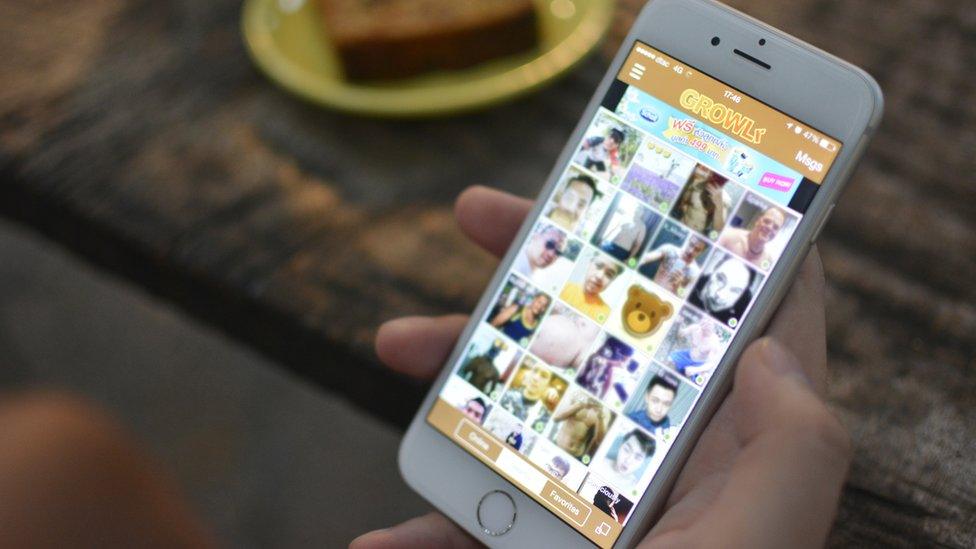Dating apps prove factor in HIV rise among adolescents
- Published

One in eight new HIV infections occurs in adolescents, making this group a key target for health advice
More adolescents are killed by HIV/Aids around the world than by anything else, apart from road traffic accidents.
While HIV infection rates have been falling globally in the past 10 years or so, among adolescents in some regions they have been on the rise - prompting fears of a "hidden epidemic".
One in eight new HIV infections occurs in this group of young people.
In Asia, according to a recent Unicef report, external, the epidemic is growing fastest in young gay and bisexual men. And one of the factors behind this trend is thought to be an increase in casual sex with multiple partners, driven by mobile dating apps.
Nest is 19 and lives in Bangkok, Thailand. He uses mobile apps like Grindr and Growlr to meet and date other gay adolescents.
"I don't like to have sex at the first meeting, I prefer to chat and get to know the person first," he says.
"But some of my friends just meet up for sex. If you go on Growlr, there will be around 50 guys available during the day, or 100 at night."
Nest practises safe sex but not with his regular partners. It took time for him to build up the courage to go for his first HIV test and he was relieved to find he was in the clear.
"I was very tense. I read all about HIV on the internet and what would happen if I got a positive result. I've been safer since then."
Risk-taking
Like many other adolescents, Nest is using dating apps to hook up to a sexual network and meet people nearby for casual sex.
Wing-Sie Cheng, Unicef regional advisor for HIV and Aids in Bangkok, says she suspects many young men and women are being put at risk.
"It's not just one to one, it's one to many, so the risks of acquiring HIV go up."
Although there is no evidence directly linking apps to HIV infection rates, their increasing prevalence means there is a "need to sound alarm bells", she adds.
Adolescence is traditionally a time when teenagers engage in risky behaviour and look to experiment and gain more independence.
The rise in ownership of smartphones and the popularity of social media has opened up opportunities for them to express themselves.
And that's prompted organisations like Unicef to start working with the companies running dating apps to help users act responsibly.

Mobile dating apps are thought to be driving an increase in casual sex with multiple partners in south-east Asia
This age group is vulnerable and needs support - and using social media to offer that is obvious, Wing-Sie Cheng says.
"We need to communicate with them in a way they recognise, in their language.
"Our role is not to judge them but to facilitate access to health services."
Apps offer advice
Gay dating app, Blued, is one of the most popular of its kind in China. Unicef has worked with it to put a red ribbon on every picture to remind users about Aids. The app also provides information on how and where to go for an HIV test.
With more than one million active users across 192 countries, Grindr is the largest and probably the best-known gay platform. The app now encourages users to go for an HIV test and points them towards the nearest testing centre.
The aim is to raise HIV testing rates to 90% in at-risk groups. At present, they vary widely across different regions.
But there are other issues to be confronted too.
Parental consent is needed before a teenager can take an HIV test in many countries, with 11 in Asia including Vietnam, Cambodia and Thailand.
Although this requirement is intended to protect under-18s, it also makes adolescents less likely to go for a test because they have to involve their parents.
Rather than being a useful protective measure, parental consent has become a barrier to testing and treatment, experts say.

Facts on adolescents with HIV
2.1 million 10 to 19 year olds are living with HIV, out of an estimated 35.3 million people in total
56% of them are girls
85% of them live in sub-Saharan Africa
South Asia has the highest number of adolescents living with HIV outside of sub-Saharan Africa
There were 300,000 new HIV infections in adolescents in 2012 - that's 13% of all new infections globally
Around 830 adolescents are infected every day

Girls are judged
In other regions of the world, adolescents are vulnerable too - but for different reasons.
In sub-Saharan Africa, it's girls who are most at risk of HIV because of high rates of teenage pregnancies, child marriage and poverty.
In areas where drug usage is high and sex work is common, HIV tends to flourish too.
A paper, external published in the Journal of the International AIDS Society described some of the many challenges faced by teenage girls.
"Often adolescent girls do not know where and how to obtain the health services they need. Even when they are able to obtain health services, they are often reluctant to do so because of fears about privacy, confidentiality, of being judged and of being treated with disrespect."
In every region of the world, HIV affects different groups of young people in different ways, making the solution unique to each location.
However, Dr Venkatraman Chandra-Mouli, an expert in adolescent sexual and reproductive health at the World Health Organization, says there is one common failing - and that's a lack of proper sex and sexuality education.

Young people end up finding out about sex on the internet if they are not given good sexuality education in school
"Girls find out about sex from their sisters and cousins, or in the playground. Their mothers don't talk to them, their teachers skip the relevant chapters at school."
And yet if they have access to the internet, in just a few clicks they can be viewing hard core pornography.
Let's talk about sex
Inadequate sex education for boys and girls is a global problem, he says, and it means young people are growing up without understanding puberty, relationships, how to make responsible choices and without the life skills they need.
Dr Chandra-Mouli admits getting sex or sexuality education right isn't easy - but it's possible, as a number of countries, such as Estonia, Sweden and Colombia have demonstrated.
He believes the rewards will make the end of the AIDS epidemic more likely - a global target for 2030.
"This is a 'never before' moment in adolescent health," he says.
"HIV is a key priority - but this isn't just about a lack of contraception."
Good sexual education means young people will feel more comfortable about who they are and what they should do to stay healthy.
In a technology-obsessed adolescent world, sexual health and mental health appear to go hand in hand.